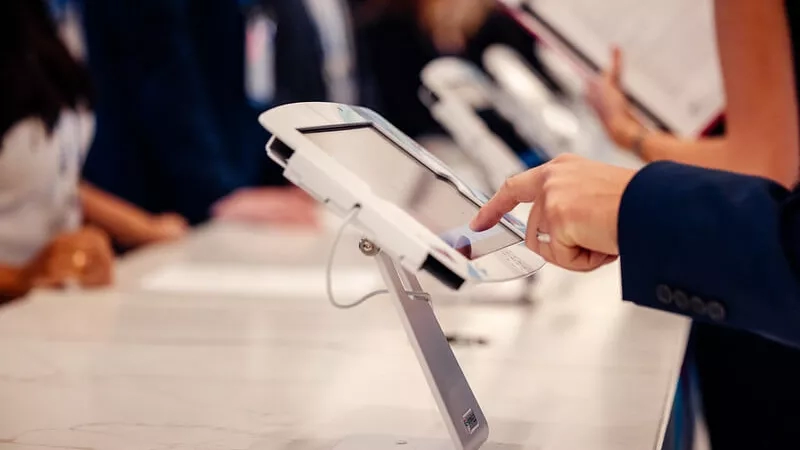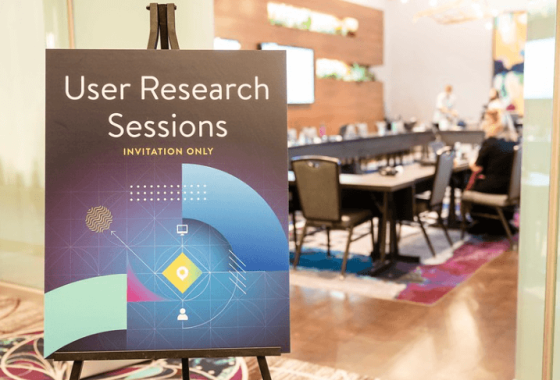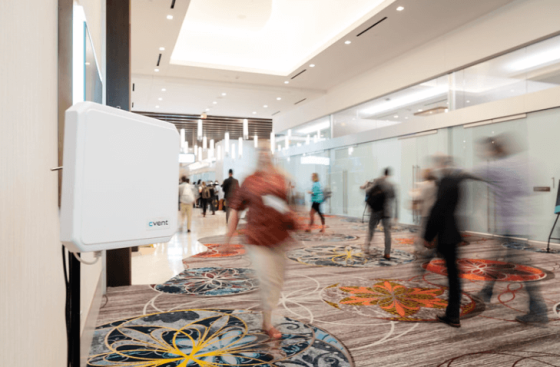Trade shows are a rare chance to meet face-to-face with potential customers, partners, and industry influencers all in one place. They’re high-energy, high-stakes environments where first impressions and real connections can impact your bottom line.
But just showing up won’t cut it—without a plan, even the best booth can get lost in the hustle and bustle.
To turn these events into real lead-generating, brand-building opportunities, you need a trade show marketing plan that’s as dynamic as the event itself. This guide includes key strategies, tech tips, and practical advice to make your next trade show worthwhile.
What is trade show marketing?
Trade show marketing is how companies present and promote their brand, products, and services at industry-specific events. These events bring together industry players, potential customers, and partners in one place, giving businesses a chance to network and showcase their expertise. Moreover, 82% of trade show attendees have buying authority, so these events are the perfect place for B2B lead generation and sales.
Creating a trade show marketing strategy
Getting people to your trade show booth requires a trade show strategy that’s a mix of planning, design, and communication. To differentiate yourself, you need to set specific goals, have unique booth designs, and create trade show marketing materials.
Define your goals
Do you want to sell your product (think revenue), generate leads, grow your email list, or launch a product? Each goal impacts your marketing strategy, so be as specific as possible. For better tracking, break down goals into achievable, measurable objectives like 100 qualified leads or 50 product demos.
Choose the right event
Research events in your industry and see which ones align with your business objectives. Websites like the Trade Show News Network list all the trade shows to help you shortlist suitable ones. Go for events that target your audience, have industry-relevant exhibitors, and have a history of good attendee attendance and engagement.
Automate meeting scheduling with the right people
Enable trade show attendees, prospects, and customers to request meetings directly. Share meeting information and document links before meetings to ensure attendees are prepared.
Make your booth stand out
Your booth should reflect your brand and be big, bold, and interactive. Use big banners and high-quality signage to tell your story.
Create compelling marketing materials
Make sure your booth is stocked with great marketing materials. From brochures and business cards to digital content like QR codes, ensure they’re informative, communicate your value proposition, direct attendees to your website, and have a clear call to action.
Event marketing on social media channels
Pre-event promotion is crucial to get your booth seen. Share teaser posts on social media before the event to hype up what attendees can expect. During the event, post live updates and encourage booth visitors to share their experiences with a unique hashtag for more visibility beyond the trade show floor.
Train your team like champions
Your booth staff represents your brand, so they should be well-prepared and engaging. Role-playing different scenarios can help your team feel confident answering questions, interacting with visitors, and qualifying leads during the big day.
Also, train them in product knowledge, communication techniques, and lead capture methods. You can capture leads using trade show lead capture software or any other solution that offers this feature.
7 trade show marketing strategies
Here are some trade show marketing strategies to help you stand out and get the most out of each show.
1. Gamify your booth
Gamifying your booth attracts people and creates a fun, interactive experience that attendees will remember. Try games or challenges related to your industry or product. For example, you can have:
- Industry Trivia: Set up a quick quiz that educates attendees while entertaining them.
- Interactive Spin-the-Wheel: Offer prizes or discounts for attendees who spin a digital or physical prize wheel at your booth.
- Skill-Based Competitions: Host challenges where attendees can win rewards based on skill, such as a timed challenge related to your product or a trivia challenge.
2. Hold workshops or mini-seminars
Workshopsand mini-seminars position you as a thought leader in your industry and provide attendees with education and insights. Hosting short sessions at your booth or in a nearby conference room creates a learning environment that attracts engaged attendees. When hosting such sessions, make sure to:
- Select Relevant Topics: To offer immediate value, choose topics that directly address the pain points, trends, or innovations in your industry.
- Be Hands-On: Where possible, let attendees experience part of your product or service through demos or free trials.
- Make it Interactive: Keep the session dynamic, including Q&A, live polls, or feedback discussions. Engaged attendees are more likely to remember and share their experiences.
3. Partner with industry influencers
Influencers have much power over brand perception, and partnering with them at trade shows can amplify your message and attract a relevant audience. Here’s how to get it right:
- Bring Influencers to Your Booth: Host influencers at your booth for live demos or Q&A so their followers can stop by and engage with your brand.
- Live Coverage: Ask influencers to share live updates from your booth featuring exclusive demos or new products.
- Branded Experiences: Create shareable moments for influencers, like a personalized demo or an exclusive product preview, to add credibility to their endorsement.
4. Offer show "specials"
Show specials give attendees a reason to buy now, creating a sense of urgency and excitement around your booth. These special offers not only bring people in but also provide a direct path to conversion.
- Show-Only Discounts: Offer limited-time discounts that are only available at the show. Promote these at your booth, in pre-event emails, and on social media.
- Product Bundles: Create a special bundle of your products or services at a lower price. Bundling is a great way to introduce customers to multiple offerings and increase perceived value.
- Pre-Registration for Services: If your product requires setup or training, offer free or discounted onboarding sessions for those who sign up at the show.
5. Invest in great visuals and branding
Visuals are key on a busy trade show floor. To make a lasting impression, ensure you have great visuals and consistent branding across all booth elements.
- Theme: Use a consistent color scheme, fonts, and messaging that matches your brand so attendees recognize and remember your brand.
- Big Signage: Eye-catching banners and signs can make a big impact. Keep it simple and use clear messaging to convey your value proposition in less than five seconds.
- Digital Displays: Digital screens and interactive displays can show product features and customer testimonials or run video demos.
6. Targeted networking
Networking at trade shows is not just about meeting as many people as possible; it’s about meeting the right people. A targeted approach will help you connect with prospective clients, partners, and industry leaders. To network effectively,
- Do Pre-Event Research: Identify key attendees, such as decision makers or influencers in your industry, who will be at the show. Use LinkedIn or event apps to connect and schedule meetings before the show.
- Personalized Discussions: When networking, tailor your conversations to each contact’s interests and needs. Being authentic and listening goes a long way in building relationships.
- Post-Show Follow-Up: After the show, follow up quickly with personalized messages to each contact, summarizing what you discussed and proposing a next step, like a call or meeting.
7. Host scheduled live demos
Live demos are a great way to showcase your product and attract attention to your booth. A good demo highlights your product’s unique features, answers real-time questions, and offers instant value.
- Schedule Demos Throughout the Day: Have demos at set times so your booth is always busy. Promote these demo times in your booth. on your mobileevent app, and on social media to attract an audience.
- Keep It Short and Sweet: Demos should be informative but not too long, so focus on the most impressive or valuable bits.
- Make It Interactive: Where possible, let attendees try the product themselves or participate in the demo for increased engagement and information retention.
Post-Event strategies for maximum ROI
The work doesn’t stop when the show is over. Following up is key to converting new leads into long-term relationships. Post-event strategies include:
Sending personalized follow-up
Follow up with leads within 48 hours of the event while the interaction is still at the top of their mind. You can personalize your messages by referencing what you discussed at the booth and including a feedback link.
Segmenting leads
Segment leads by their interests and engagement at the show so you can target your follow-up communications to their specific needs or product interests.
Sending thank-you emails
Send a quick, personalized thank-you to those who stopped by your booth to build relationships and increase brand recall.
Sharing event highlights on social media
Share a wrap-up of the trade show on different social media channels, with highlights and key takeaways. If possible, thank your influencers, sponsors, and attendees and tag them for maximum reach.
Reviewing performance and getting feedback
Review metrics like booth traffic, engagement rates, and lead quality to measure your trade show performance. Get feedback from staff, attendees, and clients to see what you can improve for your next show.
How technology can help
Increase attendee engagement, streamline lead capture, and get valuable insights by using the right technology. You can use:
- VR/AR for Demos: Virtual and Augmented Reality tools can give attendees a deeper look into your products or services and show them in action or in real-life applications. Use VR to simulate product usage in real-world scenarios or AR to create interactive product catalogs.
- Digital Lead Capture: Replace paper sign-ups with digital options like lead-capture apps or badge scanners. These tools will give you accurate, fast data capture and integrate with CRM systems for almost instant follow-ups.
- Real-Time Insights: Use analytics tools to measure booth traffic, engagement, and popularity of different sessions at your booth. Most trade show software solutions have in-built reports to help you make informed decisions for future events.
Make trade show marketing work for you
Trade show marketing is useful in differentiating your brand, getting valuable leads, and establishing your industry presence. From pre-event planning to post-event follow-up, every step counts to get your trade show ROI. We hope the steps mentioned above will help you get started. Over to you now.









